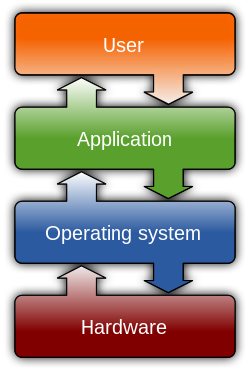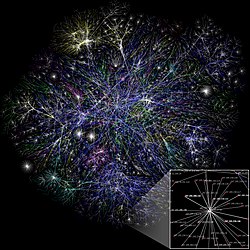
Back Rekenaarnetwerk Afrikaans የኮምፒዩተር አውታር Amharic شبكة حاسوب Arabic কম্পিউটাৰ নেটৱৰ্ক Assamese Rede d'ordenadores AST Kompüter şəbəkəsi Azerbaijani Камп’ютарная сетка Byelorussian Кампутарная сетка BE-X-OLD Компютърна мрежа Bulgarian कंप्यूटर नेटवर्क Bihari
This article needs additional citations for verification. (June 2023) |
| Part of a series on | ||||
| Network science | ||||
|---|---|---|---|---|
| Network types | ||||
| Graphs | ||||
|
||||
| Models | ||||
|
||||
| ||||
| Operating systems |
|---|
 |
| Common features |
A computer network is a collection of communicating computers and other devices, such as printers and smart phones. Today almost all computers are connected to a computer network, such as the global Internet or an embedded network such as those found in modern cars. Many applications have only limited functionality unless they are connected to a computer network. Early computers had very limited connections to other devices, but perhaps the first example of computer networking occurred in 1940 when George Stibitz connected a terminal at Dartmouth to his Complex Number Calculator at Bell Labs in New York.
In order to communicate, the computers and devices must be connected by a physical medium that supports transmission of information. A variety of technologies have been developed for the physical medium, including wired media like copper cables and optical fibers and wireless radio-frequency media. The computers may be connected to the media in a variety of network topologies. In order to communicate over the network, computers use agreed-on rules, called communication protocols, over whatever medium is used.[1][2]
The computer network can include personal computers, servers, networking hardware, or other specialized or general-purpose hosts. They are identified by network addresses and may have hostnames. Hostnames serve as memorable labels for the nodes and are rarely changed after initial assignment. Network addresses serve for locating and identifying the nodes by communication protocols such as the Internet Protocol.
Computer networks may be classified by many criteria, including the transmission medium used to carry signals, bandwidth, communications protocols to organize network traffic, the network size, the topology, traffic control mechanisms, and organizational intent.[citation needed]
Computer networks support many applications and services, such as access to the World Wide Web, digital video and audio, shared use of application and storage servers, printers and fax machines, and use of email and instant messaging applications.
- ^ Peterson, Larry; Davie, Bruce (2000). Computer Networks: A Systems Approach. Singapore: Harcourt Asia. ISBN 9789814066433. Retrieved May 24, 2025.
- ^ Anniss, Matthew (2015). Understanding Computer Networks. United States: Capstone. ISBN 9781484609071.
© MMXXIII Rich X Search. We shall prevail. All rights reserved. Rich X Search
